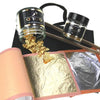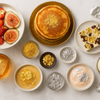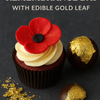How to Use Edible Gold Leaf for Kintsugi-Style Creations: A Luxurious Culinary Art
- by sam@wrightsoflymm.co.uk User
Kintsugi, the ancient Japanese art of repairing broken pottery with lacquer mixed with powdered gold, celebrates imperfection by turning flaws into beauty. Today, this philosophy is inspiring a new trend in culinary presentation—using edible gold leaf to mimic kintsugi on desserts, pastries, and plating. If you’ve ever wanted to add luxury and symbolism to your food, using edible goldleaf, gold dust, and even silver leaf in a kintsugi style is an elegant and meaningful way to do so.
In this post, we’ll explore creative ways to use 23ct and 24ct gold leaf, gold flakes, and silver dust to bring kintsugi-inspired flair to your dishes, while also giving you practical tips to master this delicate medium.
What Is Edible Gold Leaf?
Before diving into kintsugi-inspired applications, let’s define edible gold leaf. Made from pure gold—typically 23ct or 24ct—edible goldleaf is completely safe for consumption when certified food-grade. It comes in various forms: sheets, flakes, dust, and even spray. Similarly, silver leaf, silver dust, and silver flakes offer a cool-toned alternative to gold, perfect for icy or moonlit-themed dishes.
Because it's tasteless and odourless, gold and silver leaf do not affect the flavour of food, but they add an irresistible visual appeal and a sense of luxury that’s perfect for special occasions or upscale dining.
How to Create Kintsugi-Inspired Edible Art
Mimicking kintsugi using gold leaf involves recreating the look of golden cracks or seams in food—without breaking anything. Here's how you can do it:
1. Decorating Broken or Split Baked Goods
One of the simplest ways to channel the kintsugi aesthetic is by using 23ct gold leaf or gold flakes to highlight natural cracks in cakes, cookies, or pastries.
-
Gently tear or slice a cookie or sponge cake and press it back together with a thin layer of edible glue or icing.
-
Once reassembled, apply goldleaf directly over the seam using a fine brush or tweezers.
-
The result? A stunning, gilded “crack” that evokes the beauty of imperfection.
You can substitute gold leaf with silver leaf or silver flakes for a cooler, more modern twist.
2. Using Gold Dust or Silver Dust for Painting Cracks
Gold dust and silver dust are versatile tools for painting. To mimic kintsugi lines:
-
Mix the dust with a few drops of clear alcohol (like vodka) or lemon extract to create edible paint.
-
Use a fine-tipped food brush to paint "cracks" on macarons, chocolates, or fondant surfaces.
-
This technique works beautifully on moulded desserts or domed cakes, offering a dramatic effect.
For even more depth, layer both gold dust and gold flakes to create texture within the painted seams.
3. Kintsugi-Inspired Plating Techniques
Modern plating has evolved into an art form. Use 24ct gold leaf or silver dust to create kintsugi-inspired patterns on serving plates or around the base of a dessert.
-
Apply edible adhesive in curved lines or broken arcs across a ceramic or slate plate.
-
Press sheets of goldleaf or silver leaf into the pattern and gently brush off the excess.
-
Place your dessert delicately above or beside the design for a luxurious final presentation.
This technique is ideal for formal dining, weddings, or chef’s table experiences.
Practical Tips for Working with Edible Metals
-
Use Dry Tools: Water causes gold and silver leaf to disintegrate. Always use dry, static-free tools like soft brushes or tweezers.
-
Minimize Touching: Goldleaf is ultra-light and can stick to skin. Handle gently and apply using parchment or backing paper.
-
Store Properly: Keep your gold flakes, silver dust, and leaf sheets in airtight containers to protect them from humidity and static.
Final Thoughts
Combining the poetic spirit of kintsugi with the luxury of edible gold leaf offers a breath-taking way to elevate your food presentation. Whether you choose to apply 23ct gold flakes on a wedding cake or hand-paint silver dust lines on chocolates, this technique not only adds beauty but also tells a story—of embracing flaws, celebrating resilience, and finding value in imperfection.
With a little patience and creativity, anyone can master this modern culinary artform. So go ahead—crack open your next dessert, and fill the seams with gold.






